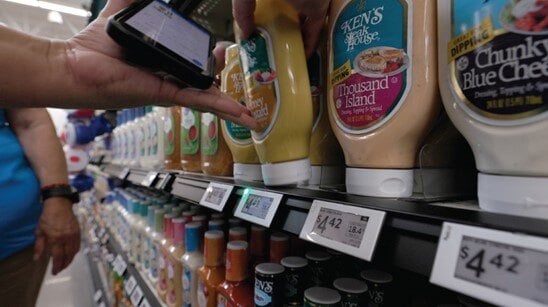E Ink’s Electronic Shelf Labels (ESLs) are becoming the new normal. With their extremely low power consumption, wide viewing angle, and the ability to wirelessly update content, ESLs are transforming the way retailers manage pricing and product information.

Source: E Ink
Benefits of ESLs
Traditional paper price tags require frequent manual updates, which can lead to inefficiencies and potential pricing errors. ESLs help to limit these issues by offering:
- Wireless updates: prices and product details can be updated remotely in minutes, significantly reducing labor costs and time spent on manual updates.
- Low power consumption: E Ink displays only consume power when updating, allowing batteries to last up to five years.
- Enhanced readability: unlike traditional digital displays, E Ink labels offer a paper-like appearance with a wide viewing angle and are easy to read.
- Color options: available in black and white, three, or four-color variations, these displays allow for promotions and product highlights that increase shopper engagement.
- Temperature range: the most durable E Ink displays function in temperatures as low as -25°C, making them ideal for use in colder environments like fridges and freezers.

Source: Walmart
Walmart and Aldi’s ESL Rollout
Walmart is the latest major retailer to start adopting ESL, aiming to implement ESLs across all 23,000 U.S. stores by 2026. With paper labels, it would take two days for employees to update prices, but with ESLs, prices can be updated within minutes. This means that employees can be utilized elsewhere, the process is more efficient, and there are less opportunities for errors.
Beyond pricing updates, Walmart’s ESLs have LED flashing capabilities that help to streamline processes. For example, there are specific indications for stocking guidance so employees can quickly locate and replenish inventory. They can also help identify the specific location items for online orders, speeding up the process and allowing more orders to be completed.
Aldi is also rolling out ESLs, starting in Germany and moving internationally. Their ESL journey started in 2019 and has come a long way since then, now equipping over 7,500 stores with over 25 million ESLs. Like Walmart, Aldi also utilizes their ESLs for updating prices within a few clicks, saving employees for other tasks. Their ESLs also have LED flashing to help fill customer pick up orders faster and more efficiently.

Source: E Ink
Expanding Market Opportunities
While grocery stores are among the biggest adopters of ESLs, other industries are also recognizing the benefits. ESLs can be used in applications such as electronics and appliances, pharmacies, cosmetics, department stores, and clothing retailers.
ESLs can also be used to provide more than just price information. They serve as a digital communication tool that can show promotions and discounts, competitor pricing, customer reviews, product ingredients, currency conversion, inventory levels, and more.
ESLs enable businesses to optimize operations and enhance customer experience. With their ability to improve efficiency, reduce pricing errors, and offer product information, they are set to become the new standard in retail pricing and beyond.
Looking for more information on ESLs? You can visit our website here or see our full list of ESL system integrators here.


Leave Comment